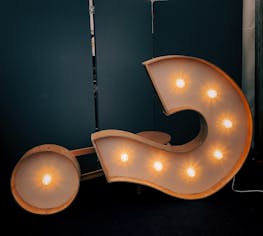Denmark is nothing if not consistent – and also extremely happy. In fact, the Danes are so happy and consistent that they rank in the Top 10 Happiest Countries, and have maintained a top-five position for numerous years. So, as it turns out, William Shakespeare may have been wrong about Denmark. There doesn't seem to be anything rotten there at all.
The Little Book of Hygge is a charmingly beautiful manual, aimed at making our lives better, through embracing comfort, warmth, and generosity. It delves into the Danish sensibility where much of their famed happiness centers on "hygge," or "coziness."
Meik Wiking is a bestselling author, and CEO of the Happiness Research Institute. When it comes to understanding happiness, there really isn't anyone who is better equipped to deal with the subject. His books have won international acclaim, and Wiking is recognized by Time magazine as the world's happiest man.
We'll briefly begin by defining hygge, and then we'll show how we can all bring a little bit of Danish magic into our lives. So, if your life needs a little bit of brightening up, or if you feel the need to be more fulfilled, this is an utterly charming and heartwarming book to cozy down with. Not only is hygge is part of the Danish spirit and culture, it's also encapsulated in the delightful writing style, and the beautiful illustrations and photographs.
Happiness Lives Here
Denmark is a country that prides itself on work-life balance. While business and careers are important, the Danes also place a very high value on leisure time, family, and solitude. The country's social, political, and economic structure allows for a very high quality of life; however, there's another compelling factor to how Danes experience everyday life.
Everyday life in Denmark is frequently dark and cold because of their winters, and their summer months are also relatively cool. While some people might moan about the cooler climate, the Danes embrace it because it's the ideal setting for "hygge." And hygge is at the center of Danish happiness.
So what exactly is this mysterious hygge?
Hygge is the pursuit of everyday happiness – it's about finding joy in the experience of each and every day. It's about finding an appreciation for the small things that add huge value to our lives. This appreciation manifests itself in Danish culture, because hygge is also about togetherness and sharing. While you can experience hygge by yourself, the Danes put a lot of emphasis on spending time in intimate groups. The core ideas are around well-being, coziness, warmth, safety, intimacy, and gratitude.
Hygge has been described in several ways: 'the art of being consciously cozy,' 'a hug without touching,' 'socializing for introverts,' 'cocoa by candlelight.' Anything annoying or invasive is the antithesis of "hygge."
Although hygge is about creating an idyllically cozy atmosphere, it isn't an aesthetic. Where people often misinterpret it, is that it's not about consumerism or commodification. Recently hygge has shot into the stratosphere of popularity. It was shortlisted for the Collins dictionary word of the year in 2016, but ironically Brexit got the vote. Whereas Brexit is exclusionary, hygge is all about a spirit of sharing, togetherness, and equality. Social media influencers, Pinterest users, and YouTubers have taken to hygge in a massive way, and it's lost a lot of its original ethos. For example, a precursory Google image search will show images of perfection. These images reveal an idyllic chocolate-box world with chunky socks, perfectly coordinated color schemes, elaborate lighting concepts made to look like candles, piles of woolen blankets, and expensive wooden furniture. While some of these elements are hygge, Wiking asserts that hygge is for everyone, it's not a design scheme, and it shouldn't necessarily come with a hefty price tag.
So, you'd be wrong to listen to the social media influencers and hygge appropriators. You don't have to go out and spend a fortune to reconfigure your home to join in the hygge revolution, and find happiness in domestic bliss. The Little Book of Hygge shows us simple ways to make our lives better, how to embrace the spirit of hygge,and the importance of identifying "hygge moments." Furthermore, it's about embracing life's small moments, sharing them with others, and being more mindful of life's beauty and wonder as it occurs.
So what are some of the little things that make your life better, and let's see if these encompass the spirit of hygge?
Let There Be Light
How do you feel when you walk into a room with fluorescent or bright lights?
Many of us feel overwhelmed, annoyed, disoriented, uneasy, or stressed. These feelings are the opposite of hygge.
Hygge is all about feeling maximum levels of comfort and coziness. Hence, the very first step is to create an atmosphere that's welcoming – even if you're just welcoming yourself. Creating an atmosphere often comes down to lighting, and for the Danes, there's nothing more essential than an abundance of candlelight. If you're fortunate enough to have a fireplace in your home, this definitely creates a "hygge-like" atmosphere.
While hygge isn't about accumulating things and relying on objects to create the experience, you're going to have to invest in lots of candles. The good news is that there's nothing less hygge-like than expensive scented candles. This isn't the time to load up on fancy candles endorsed by celebrities – candles shouldn't cost more than a couple of dollars.
Candles are so crucial that the Danes burn the most candles in Europe. On average, a Danish person burns just over 13 pounds of candle wax per year. Wiking explains, 'No recipe for hygge is complete without candles. When Danes are asked what they most associate with hygge, an overwhelming 85 percent will mention candles.'
The candle is so fundamental to the Danish state of being, that if a Dane were to refer to you as a "lyseslukker," you'd better take a long hard look in the mirror. This insult can be translated as "someone who puts out a candle." Candles are so ubiquitous, and so much a part of daily life, that they're found in almost every Danish building. So whether you're at home, in a coffee shop, in an office block, or classroom, you're bound to find an abundance of candles.
Switch to Silent
Are you the type of person who finds it very annoying when someone's cellphone goes off in a cinema or quiet space?
Noise can pierce through the tranquility of an atmosphere, and completely ruin a moment. When creating a cozy and welcoming experience, we need to consider the impact of both sounds and silence. Sound affects how we relate to the space around us, and it can be very distracting – particularly if it's a manufactured sound.
Whether you choose to experience hygge alone, or with other people, it's crucial to practice mindfulness and "be in the here and now." Since hygge is about enjoying what's around us, living in the moment, and being free of distractions, it means that technology should be switched off and ignored.
So, for anyone who battles with friends and family members attached to their devices, embracing hygge might be an excellent way to get them to digitally detox for a few hours.
Mindful Indulgence
Hygge is about embracing small and indulgent pleasures. However, this isn't a license to scoff down that giant slice of chocolate cake – you actually have to enjoy and appreciate it. The Danish philosophy seems to be that if you genuinely enjoy eating something, then you can delight in cakes, cookies, cheese, coffee, and so on. The idea here is that life is about enjoying pleasures, and not feeling without or restricted.
In many other cultures, mindful eating isn't practiced as often as it should be, and instant gratification results in consuming without enjoyment. The hygge philosophy is to celebrate indulgent treats, to share them, and experience them slowly. Savor the moment. And don't rush what you're putting into your body.
The Danish coffee shop is at the heart of hygge – in fact they have a word called kaffe-hygge. By bringing together lighting, atmosphere, warmth, beverages, and delicious homemade treats, the simple act of meeting a friend for coffee can be intensely hygge-like. However, kaffe-hygge also brings together the idea of good quality and ethically sourced ingredients.
We're all Equal and Should Live in Harmony
Ethics, equality, fair, and organic are some of the other words you're likely to find in the hygge lexicon.
The Danes pay high taxes, but you'll seldom hear them grumble about this. Despite the high taxation, Denmark is a very equitable country, and the taxes are used on free quality education, free healthcare, excellent infrastructure, an efficient transport system, and an abundance of cultural and recreational facilities.
The mindset of the Danish population is that community is paramount. Whereas other countries adopt a singular, and "me" attitude, the Danes are all about the collective "we." This sense of community and togetherness imbues all aspects of daily life, and even though solitude and being alone is encouraged, the sense of community is solid.
If you don't like sharing, then hygge is probably not something that you'll relate to. Hygge is all about sharing meals, being hospitable, sharing moments, and sharing conversation. It's about listening and not being arrogant or self-involved. Life isn't a competition; it's about everyone enjoying things together, and sharing in the joy and simple pleasures.
Oh, and if you plan on discussing politics, save it for later. Hygge moments mean shelving any differences of belief and embracing the spirit of unity and togetherness.
Keeping it Together
The spirit of unity, togetherness, and gratitude is paramount to experiencing the true wonder of hygge. However, hygge isn't about large crowds; it's about intimacy.
What better way to experience this than by telling stories and reminiscing? Hygge embraces nostalgia and capturing those beautiful memories and moments. However, hygge isn't just about the significant events like Christmas, birthdays, and so on. Hygge is about making the everyday something to celebrate. Americans give thanks once a year, but why not do this more often? You don't have to put on an elaborate feast to convey gratitude. The Danish mentality is that exercising gratitude and being thankful is part of every meal. After all, the moment you're experiencing now could be as good as it gets.
When was the last time you enjoyed a family dinner?
Family dinner isn't just about sharing a meal with relatives – it's about acknowledging that family comes in many forms. We are social animals and form kinship through storytelling and creating memories. Relationships are continually being built upon, so never take that family meal for granted. Set the table, turn off devices, light candles, and share a nourishing meal together.
Home is Where the Hygge Is
Finding comfort in one's home is the essence of hygge. The Danes put a lot of emphasis on their homes because they spend a lot of time in them.
The Nordic Lifestyle has become increasingly popular. The Nordic aesthetic is so popular that some people even refer to it as "furniture porn." There's no doubt that the Danes are passionate about design and aesthetics, but that doesn't mean that creating a home around the idea of hygge, should be expensive.
Nonetheless, our author does recount a delightful story of when he was a student and spent his hard-earned salary on a very expensive chair. He spent a month's salary on an antique chair and got to enjoy it for two years before it was stolen. Wiking, the happiest man in the world, wryly muses, 'needless to say, I was angry that my beautiful chair had been stolen. But at least the burglars had good taste'. Few things capture the Danish sensibility more than this.
71% of Danes experience hygge at home. So, with this in mind, how can we create that feeling of harmonious home-based hygge? The first thing is to focus on things that are relaxing, comforting, cozy, and snug. But remember, it's not about perfection or huge expenses. Wiking suggests that to create a hygge-like space, we need to ask ourselves: 'How would a Viking squirrel furnish his living-room?'
Here are a few ways to get started if you want to bring hygge into your home.
Many Danes have a sanctuary or "nook" in their homes called a "hygge-krog." You don't have to have a bay window, or even a large house to create your own hygge-krog. On the contrary, Danes celebrate small spaces because they're safe and welcoming. With a little imagination and some cozy cushions, blankets, a few books, and obviously the obligatory candles, you'll be able to create some Danish magic in your own home.
If you have a fireplace, stock up with wood and use it. What's more, invite friends and family members to share the space with you. If you don't have a fireplace, create other ambient spaces in your home by lighting lots of candles, creating pools of light, and providing blankets and comfy areas to relax. A dining room or kitchen table is another great space to share with people.
When thinking about what makes a home hygge-like, focus on natural materials, wood, and bringing the outside in. Highlight all of the beautiful books around you, have an abundance of blankets, cushions, and textures. And finally, remember that hygge is about appreciating what you have. After all, simplicity is happiness.
In Conclusion
Hygge is a noun, and a verb, and a feeling. Hygge can also be an adjective – something can be hygge-like. Perhaps hygge has also become a Zeitgeist, a rebellion against capitalism and instant gratification? However we define it, it's utterly irresistible to those introverts among us. It's license to relax, license to indulge, and license to put on warm wooly socks and hunker down with a good book and a steaming hot beverage or glass of wine.
The best part about it, is that it's a shared experience, so it's guilt-free. In fact, the book provides us with recipes like meatballs and homemade bread, perfect for sharing among friends. Provided that we indulge mindfully, share abundantly, and savor each precious moment, we're completely nailing the essence of hygge.
So it could be time to slow down, turn down the lights, switch to silent, and embrace collective well-being. Maybe, just maybe, this little book isn't so little after all?




